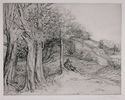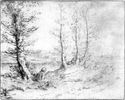
19th, 20th & 21st Century Fine Prints
707-546-7352 · fax 707-546-7924 · web: www.annexgalleries.com · email: artannex@aol.com
Alphonse Legros Biography
Alphonse Legros
French
1837–1911
Biography
Alphonse Legros was born on May 8, 1837 in Dijon, France. His father was an accountant, and came from the neighboring village of Véronnes. While young, Legros visited the farms of his relatives, and the peasants and landscapes of that part of France are the subjects of many of his works. He was sent to the art school at Dijon with a view to qualifying for a trade, and was apprenticed to an interior decorator. In 1851, Legros left for Paris, but passing through Lyon he worked for six months as journeyman muralist for painter/art restorer Jean-Baptiste Beuchot, who was painting the chapel of Cardinal Bonald in the cathedral.
In Paris, Legros studied with theater scene painter Charles-Antoine. He attended also the drawing-school of Lecoq de Boisbaudran (the "Petite école") where he found made friends with Jules Dalou and Auguste Rodin. In 1855, he attended the evening classes of the École des Beaux Arts.
Legros sent two portraits to the Paris Salon of 1857: one was rejected, and formed part of the exhibition of protest organized by Francois Bonvin in his studio; the other, which was accepted, was a profile portrait of his father. Art critic Champfleury saw the work in the Salon, and sought out the artist to enlist him in the "Realists," a group anchored by Gustave Courbet.
Legros picked up the art of etching by watching a colleague in Paris who worked as a commercial engraver, and taught himself both etching and medallion making. He considered the traditional journey to Italy an important part of artistic training, and in later years, gave part of his salary to augment the income available for a travelling internship.
He moved to England in 1863 and in 1864 married Frances Rosetta Hodgson. In his early career, he lived from the sales of his etchings and teaching. He began teaching etching at the South Kensington School of Art and in 1876 became a Slade Professor at University College, London, succeeding Edward Poynter.
While teaching at the Slade School Legros taught a large contingent of women, who came to be known as the Slade Girls. The Slade Girls attracted commissions from a range of societies and organizations due to the beauty and skill of their work. Pupils of note include the Casella sisters (Ella and Nelia), Fedora Gleichen, Lilian Swainson (later Hamilton) and Elinor Hallé.
Legros was naturalized as a British citizen in 1881, and remained at University College for 17 years. He would draw or paint a torso or a head for the students in an hour or less; in the painting school, he insisted on a good outline, preserved by a thin rub in of umber, and then the work was to be finished in a single painting.
Alphonse Legros died in Watford, Hertfordshire, England on December 8, 1911.






